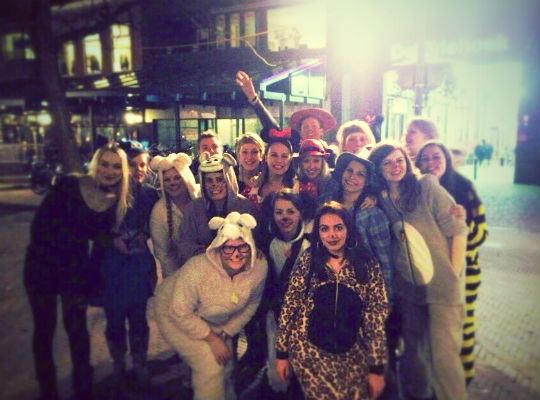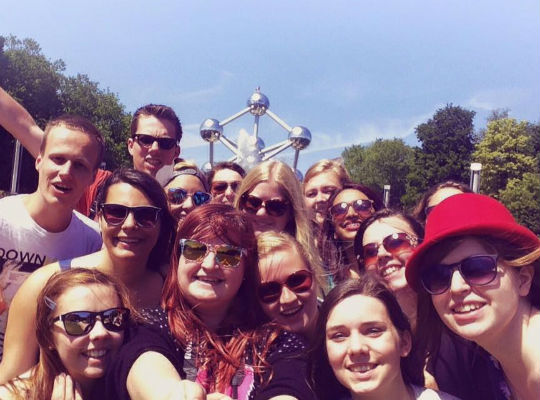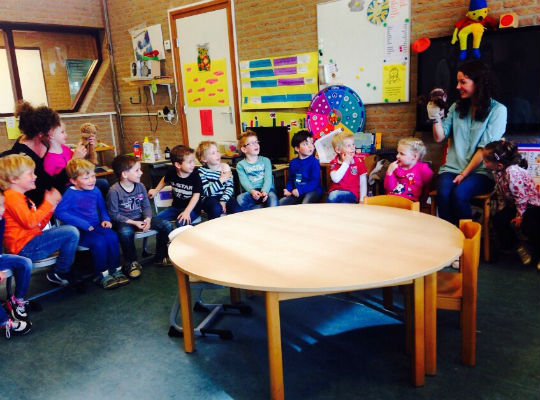Erasmus+ Journal (Issue 3) 2014/15
Michaela Schwarz, Saxion University of Applied Sciences, NL/Hengelo
Contact of University in Hengelo:
Hengelo:
074 - 851 61 00
M.A. de Ruyterstraat 3
7556 CW Hengelo
Netherlands
Contact of the Eramsus Incomings Coordinator:
Kamphuis, Sander
Exchange Programme: Teacher Training for European Competences (TEC):
Here the programme is described, in the pdf-folder all the classes are described as well:
http://www.saxion.edu/site/programmes/exchange/details/teacher-training-european-competences/teacher-training-european-competences/
My Courses:
Description of the University:
About Saxion:
Saxion University of Applied Sciences is one of the largest institutions of higher education in the Netherlands, with over 24,000 students (and still growing!). Saxion University has a rich history – its roots can be traced back to the 1875. A merger of two educational institutions, the Hogeschool Enschede and Hogeschool Ijselland, in 1998 paved the way for Saxion University in its present form. This merger enabled Saxion to build further on its strong position in Dutch higher education and since then Saxion University has come to be recognised as an important centre of expertise at regional, national and international level.
Location:
Saxion University of Applied Sciences has four campuses in the East of the Netherlands - one campus in each of the four Dutch cities of Deventer, Enschede, Apeldoorn and Hengelo. Thanks to the important contribution of agriculture to the local economy, this region is renowned for its beautiful countryside and fairly relaxed pace of life. However, all four Saxion locations have good public transport facilities, meaning that the hustle and bustle of the major cities of Amsterdam, Rotterdam, Utrecht and The Hague is no more than 1½ hours away.
So far, also this semester the Saxion's PABO has been situated in Hengelo. From the following semester onwards it will be in Enschede as well.
Hengelo is a lovely small town, very nice to live in for families but also students. It is not a proper student city, as Enschede, as it is quite small, but you can also go to a Pub and clubs or go for some shopping :)
Description of the application process:
Applications
All applications for admission must be submitted online, using a specific form available during application periods.
The course is open to 3rd and 4th year Bachelor students in a Teacher Training programme.
The students’ home institution must have an Inter Institutional Agreement (IIA) with Saxion Teacher Training College (APO Hengelo). To apply as an exchange student for this course, please contact the International Office at your home institution. Once your home institution has nominated you for this course, they will contact our International Office (internationaloffice.slh@saxion.nl). If our International Office agrees with your nomination, you may fill out the application form.
Application deadlines:
Application deadline was December 1st 2014 for the Spring 2015 course
Once you are accepted at the Saxion University of Applied Sciences you receive a ´letter of acceptance´.

The second school was called Roets, also located in the city of Almelo. There are 4 different schools working together in one building: one Christian, catholic, open and one pre-school. In one building teachers are trained how to do sports with children and receive a certificate if they pass the final test. The school was built in a neighbourhood, where a lot of non-Dutch people are living. There is also a community centre for children, which provide different activities for their leisure time. Furthermore, there is a centre for teenage-mothers, where they can meet and receive advice before giving birth to the child.
It has been a great experience to see schools like this, since I didn't really know anything like that from Austria before. A big different to the Austrian school system is, that there are no different curriculums for children with seeing-, hearing- or behaviouristic disabilities, it depends on your IQ-level whether you get into a school like "Des Oosteres" or not.
10th of March, 2015:
We went to a school called "De Ontdekkingsreis" in Doorn. The school is situated next to a big forest, where the children are allowed to play in during breaks. We had a short introduction about the school, given by the headmistress, who created the school in 2004. It officially opened in 2008. About 90 children attend this school. Their main goal is, to let children free, teach them responsibility and let them develop themselves in their own ways.
The building: After the introduction two pupils showed us around the building. It contains only a few actual classrooms. There were about 20 computers in the hallway, next to the place where children hang their coats, where children work on their exercises. There was a big playground outside with a forest to play in and even a trampoline, the teachers’ room and one big room including a kitchen, sofas, a small stage, tables and chairs. This room is divided into two rooms, only by a curtain. On the one side of the curtains there are bookshelves and a white board, chairs and tables. There the lessons are held by the teachers. Every class is divided into level groups, not age groups. On the other side, pupils have lunch, do their exercises and play.
The children can choose themselves, in which area they want to study. The different ability-areas are marked by different colours. The children can also choose what they want to do each day and write it in their timetables themselves. Some classes are compulsory though. Those are written on a whiteboard in the hall. On it, it says the different classes with its ability-groups. If a child is in this ability group, it knows, at which time it has to be in which class.
Brussels: 31st of May - 5th of June
The first week of June we went on a trip to Brussels. Together with the Dutch and international students of the international class, as well as some new Dutch students from the first year, we had the best time in this beautiful city! Every day we went for some sightseeing, received insights into the European Parliament and Commission, got the chance to observe a Belgium School and get insights into the Belgium school system.
This week was very interesting and we had an amazing time together! Every night we went for dinner together and to some bar afterwards. The city is beautiful, but the language thing is a bit complicated. It is confusing, that within not only one country but one city they speak two languages, French and Flamish (Vlaams), which is very similar to Dutch.

Brussels-Atomium
School Practical in the Netherlands:
Basic Information:
Basisschool De Regenboog
Address:
De Regenboog, Fioringras 2
7623 DR Borne
Contact:
Headmaster: Alois Hilbers
074-2663235
info@regenboogborne.nl
http://www.regenboogborne.nl/
140 Pupils
6 groups – one for each age group, 6 and 8 are mostly together, 1 and 2 are in one group
12 teachers plus one principal
Schedule: 8.30-14.00
The school's principles:
The school’s principles follow the philosophy of Piaget. The pupils shall gain their basis knowledge about themselves, by focusing on their strengths and giving each other compliments. Every child thinks about strengths of their schoolmates and tells them they think they are good at. They are asked to think about their outer strengths, such as sports, as well as their inner strengths, like creativity.
Every day the school starts at 8.30, whereas pupils can enter at 8.20 already. The teachers are usually at school by 8 o’clock. The pupils’ parents are asked to leave their children after dropping them off at school by 8.30, for the younger children in Group 1 to 3, it is 8.45. Every day school ends at 2 o’clock in the afternoon and the teachers have a break until 3 o’clock afterwards.
The groups’ breaks to go to the playground outside start at 10 o’clock in the morning. Each group as 15 minutes to play outside, then the next one comes.
We were told, that the school is currently working on a plan to introduce English lessons already from Group 1 (age 4) onwards. So far the pupils are taught English from the age of 10 for about 1 hour each week. Additionally, we were told that every teachers teaches every subject, apart from gymnastics and music. The Borne city council provides money for the school for those additional teachers.
Our practical group contained of 3 international and one Dutch student. All practical groups had at least one Dutch student, to help us with the communication with the children and teachers.
Together we conducted some activities in the classes, firstly to introduce ourselves and get to know the children a bit better. As the practical lasted for 7 days in total, we conducted some more activities within these days. Unfortunately we weren't able to do full lessons, apart from one sports lesson, but we got the chance to join them for the so-called 'konings spelen', which are games for the king's birthday, where all the children from Borne met and had a great sports event and we could conduct some activities and taught them some English, Spanish and German.
Within our placement we had to write a research paper on the internationalization within the school. Therefore, we had to do some interviews with teachers and children and write a proposal for a project for the school. Beside some observations we were able to do, this was how we spent the rest of the time at our internship.

Groep 1 en 2 (age 4-6) - Basisschool De Regenboog: Introduction games
Within the Netherlands, almost every classroom has an interactive board and, in general, is quite modern. A lot of schools use iPads, but also still work with school books.
Comparison to the Austrian school system:
Considering English lessons in the Netherlands, noticed a difference to the Austrian school system, as pupils in primary school are taught English from the age of 6. During key stage one (age 6-7) English is taught inclusively, and during key stage 2 (age 8-10) we have one compulsory weekly hour. Whilst here there seems to be a main goal given by the curriculum which describes, which abilities the children need to reach by the end of primary school. How the teachers reach these aims is up to themselves. So the school can decide when they start teaching the foreign language.
Additionally, the playground outside in this school is very different to Austrian playgrounds. I have never seen one without a fence to prevent pupils running on the street and strangers coming inside in Austria – at least not right next to the street, in the middle of the town. In Austria you only have these kind of playgrounds in more suburb- or countryside-areas.
I noticed, that group 1/2 (4-5-year olds) has a TV-screen in class, instead of a white board. I have never seen this in any classroom before. This group also received new iPads today, which is also very new to me for that age group. Additionally, every classroom has a see-through door, so you can look inside the class any time. So far I have only seen doors, which are completely wooden in my country and you cannot look inside unless you open the door. This is very nice, as it is very open and everyone knows what is happening inside. It might seem disturbing, but I think as soon as the children get used to people walking pass the door they are not distracted by it anymore. And if you need anything from the teacher inside, you don’t have to open the door to check if he/she is busy or not, as you can see it easily.
The English lessons we observed always started with some dancing along with English instructions. The students seemed to enjoy that a lot, as they could learn by doing. The tacher translated a lot into Dutch during the lesson, which would not really be necessary, as the children understand a lot, as long as you use body language and multisensory techniques. In Austria we wouldn’t be allowed to talk that much German during English lessons. We have to try, already with the 6/7 year-olds, to explain instructions by visual examples and multisensory teaching. They do it here as well, but still translate a lot.
Koningsspelen:
We also joined group 1 for the Koningsspelen (King’s games) in Borne. All schools within Borne met at a big sports court, where different activities have been organized for the children.
Each one of us was in a group with some parents. We were together with a German and an English mother and their children. As we had 4 children in total, every one looked after one child for the entire day.
The games started off with a dance as an introduction for all the children. Afterwards we followed our given schedule and started with our first activity “building castles – kaastel bouwen”. As there were a lot of children and not that many blocks, it was hard to get the children into it, but after a while they did very well. Unfortunately we had to leave after 5 minutes, because we had to go to the next game. The schedule was pretty full and, in my opinion, it wasn’t enough time for the children, especially the little ones, to enjoy every game to its fullest.
I am glad we could be part of those games, as it has been a great experience. I have never had the chance to join an excursion with a school class before, so it was very nice to be part of this.